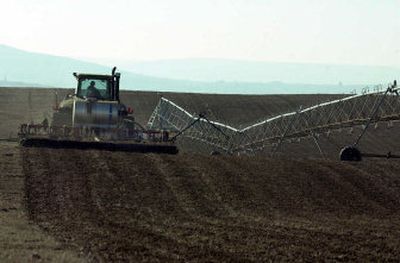Co-op seeks to corner the potato market

SHELLEY, Idaho — It took farmer Merrill Hanny three days to bury $100,000 worth of his perfectly good potatoes. He remembers how they crunched beneath his tractor as he plowed over his muddy field in the spring of last year.
Hanny destroyed part of his crop at the behest of the United Potato Growers of America, a fledgling group of regional farming cooperatives. The group aspires to be to potatoes what OPEC is to oil by carefully managing supply to keep demand high and constant, resulting in a more stable return for farmers.
The new organization has been a boon to Hanny, 53 years old, and other farmers who for years have watched potato overproduction push down prices and mash profits. “For the first time, I feel in control of my destiny,” says Hanny, who is married and has seven children.
From the french-fry farms of Washington state to the spud fields of Texas, potato farmers are joining the new movement. Formed in March 2005, United Potato says it has recruited farmers and regional cooperatives who till more than 60 percent of the potato acreage in the U.S. Some Canadian growers have also enlisted.
In the past year, United Potato helped erase 6.8 million hundred-pound potato sacks from the U.S. and Canadian markets — the equivalent of about 1.3 billion medium orders of french fries at McDonald’s. For farmers, their open-market returns surged to $10.04 per hundred pounds, up 48.5 percent from last year.
So far, for competitive reasons, supermarkets have absorbed the increased payments to farmers so potato prices for consumers have risen only slightly. In general, restaurants that serve french fries haven’t pumped up prices either, but if open-market prices remain high, farmers under contract to restaurants may have more leverage to ask for higher prices.
“We’re helping people get the message of, ‘Stop overproducing,’ ” says Julia Cissel, chief executive of the cooperative based in Salt Lake City.
United Potato says it is trying to preserve the North American potato farm. There are fewer than 10,000 potato farmers today, down from more than 50,000 three decades ago, says the U.S. Agriculture Department. That’s partly because, as with other crops, big growers are gobbling up small ones. Also, demand for potatoes has tapered off due to dietary trends. Potatoes remain the most popular individual accompaniment to a main dish, but people are cooking fewer at home.
The spud cartel’s manipulation of supply is perfectly legal. Orange, dairy and other farmers have employed similar co-ops as market stabilizers since 1922, when the Capper-Volstead Act exempted farmers from federal antitrust laws, permitting them to share prices and orchestrate supply.
Historically, growers have responded to thin profit margins by planting extra acres — which helped depress prices further.
“It’s one good year, then four or five bad years,” says Albert Wada, one of Idaho’s biggest growers. Price wars have cropped up as farmers tried to steal market share from one another.
In September of 2004, Wada and another big Idaho grower, Keith Cornelison, summoned nearly two dozen of the state’s growers to a meeting where they talked about how to curb production and boost prices. That November, Wada presented the plan to 650 state farmers in Idaho Falls. Many farmers signed up on the spot, agreeing to pay annual dues ranging from about $10,000 to $500,000, depending on how much a farmer grows.
Hanny was one. The third-generation farmer had lost about $500,000 in the previous few years and wouldn’t have planted potatoes at all — but then he found out about the co-op.
The Idaho co-op next hired Jerry Fields, a former H.J. Heinz Co. and ConAgra Foods Inc. executive, to handle business decisions. He pushed the group to go national.
Although Idaho produces around 30 percent of U.S. potatoes, Fields believed the co-op couldn’t influence prices without members from other big potato states.
The Idaho group became the national group. Fields and Wada recruited farmers from California, Oregon, Wisconsin, Colorado, Washington, Texas and elsewhere.
Some skeptical nonmembers think the co-op is merely a way to help large Idaho farmers who typically have overproduced. Says Tim Hobbs of the Maine Potato Board, “If the problem was caused in the West, the West ought to solve the problem.”
A big test for United Potato will come this spring, when higher prices could tempt members to plant more than they’re allotted. United Potato says it will monitor farmers with the aid of satellite photography and global-positioning-system technology.